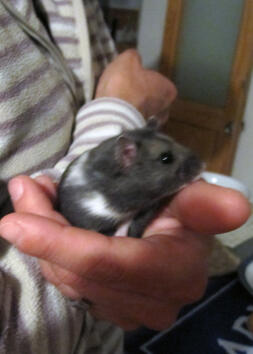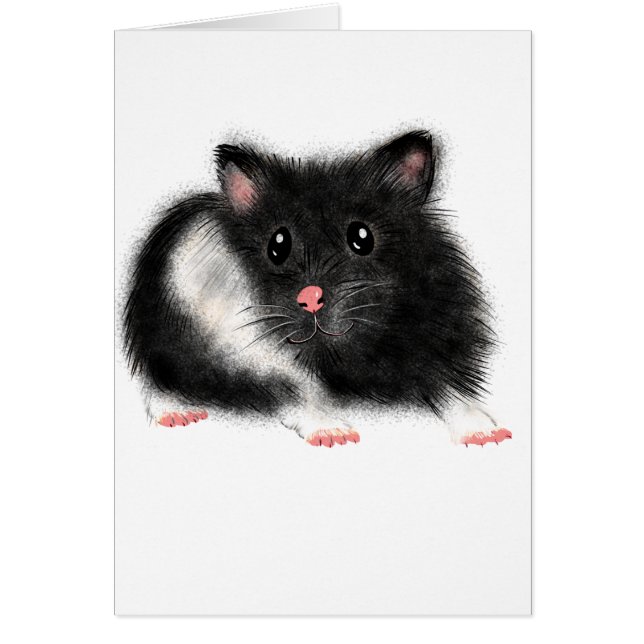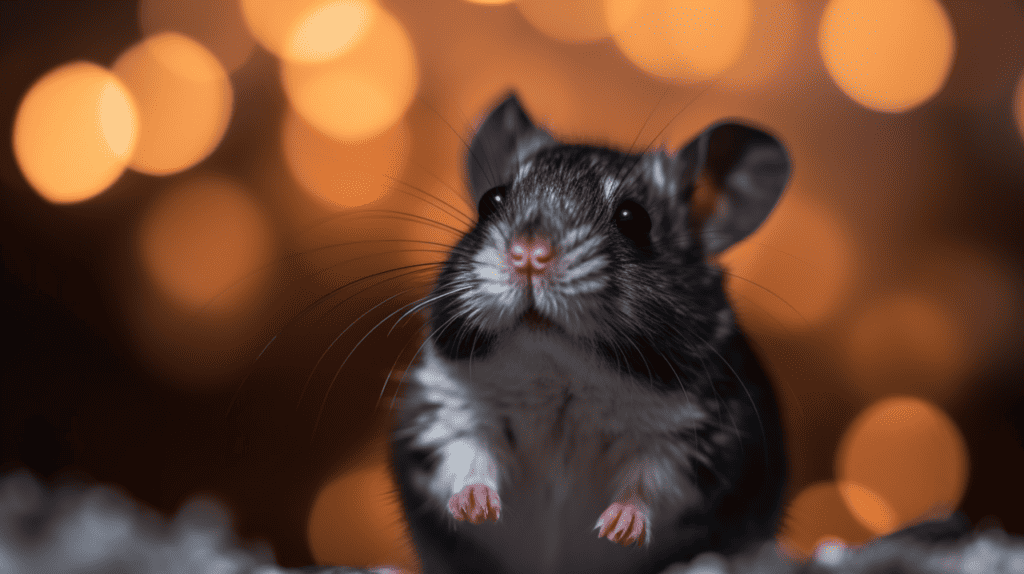Black and white hamsters are popular pets because of their striking coloration and friendly personality. They are also relatively easy to care for, making them a good choice for first-time pet owners. In this comprehensive guide, we will delve into the history, appearance, personality, care, and health of black and white hamsters. By the end, you will have all the information you need to provide the best possible care for your black and white hamster.
Can a Hamster Eat a Strawberry?
Seemore: Can a Hamster Eat a Strawberry?
History of Black and White Hamsters

Black and white hamsters are a type of Syrian hamster. Syrian hamsters were first discovered in the Syrian desert in 1839 by British zoologist George Robert Waterhouse. They were brought to Europe in 1930 and quickly became popular pets due to their small size and docile nature.
The black and white hamster is a relatively new color variety of Syrian hamster. It was first developed in the 1960s through selective breeding. Breeders aimed to create a hamster with a striking black and white coat, similar to that of a panda bear. Black and white hamsters are now one of the most popular color varieties of Syrian hamster, along with golden and cinnamon.
Appearance of Black and White Hamsters

As the name suggests, black and white hamsters have a distinctive black and white coat. The black fur is usually concentrated on the back and sides of the hamster, while the white fur is usually found on the belly and feet. Some black and white hamsters may also have a white blaze on their face, giving them a unique and adorable look.
Black and white hamsters typically have black eyes and ears. However, some black and white hamsters may have red eyes and ears. These red-eyed black and white hamsters are often called panda hamsters, as they resemble the iconic black and white bear. Red-eyed black and white hamsters are not as common as their black-eyed counterparts, but they are equally as cute.
In terms of size, black and white hamsters are typically larger than other types of hamsters. They can grow to be 6-8 inches long and weigh up to 12 ounces. This makes them one of the largest breeds of hamsters, along with the Syrian teddy bear hamster.
Personality of Black and White Hamsters

Black and white hamsters are generally friendly and docile creatures. They are known for their calm and gentle nature, making them great pets for children and first-time pet owners. They are also very social animals and enjoy interacting with their owners.
However, like all hamsters, black and white hamsters have a natural instinct to burrow and hide. This means they may become shy or skittish if they feel threatened or scared. It is important to handle your black and white hamster gently and give them plenty of hiding spots in their cage to make them feel safe and secure.
Friendly and Playful
One of the reasons why black and white hamsters make great pets is because of their friendly and playful personalities. They love to explore and play, making them entertaining companions. You can provide them with toys, tunnels, and exercise wheels to keep them mentally and physically stimulated.
Black and white hamsters are also very curious creatures. They will often stand on their hind legs to get a better view of their surroundings. This behavior is completely normal and shows that your hamster is happy and curious about their environment.
Bonding with Your Black and White Hamster
Bonding with your black and white hamster is an important part of being a pet owner. It helps to build trust and strengthen your relationship with your furry friend. To bond with your hamster, you can start by offering them treats from your hand. This will help them associate you with something positive and build a bond of trust.
You can also spend time playing with your hamster outside of their cage. This will allow them to explore new environments and get used to being handled by you. Just make sure to supervise them at all times and provide a safe and secure space for them to play in.
Individual Personalities
While black and white hamsters are known for their friendly and docile nature, each hamster has its own unique personality. Some may be more outgoing and adventurous, while others may be more shy and reserved. It is important to observe your hamster’s behavior and adapt to their individual needs and preferences.
Care for Black and White Hamsters

Black and white hamsters are relatively easy to care for, but they do require some basic necessities to thrive. Here are the key aspects of caring for your black and white hamster:
Housing
The first thing you will need to provide for your black and white hamster is a suitable cage. The minimum recommended size for a single hamster is 24 inches long, 12 inches wide, and 12 inches tall. However, the bigger the cage, the better. This will give your hamster more space to explore and exercise.
Make sure the cage has a solid bottom to prevent your hamster from escaping or getting injured. You can use wood shavings, paper-based bedding, or aspen shavings as substrate for the bottom of the cage. Avoid using pine or cedar shavings as they can be harmful to your hamster’s respiratory system.
Your hamster will also need a hiding spot, such as a small house or tunnel, to retreat to when they feel scared or stressed. You can also provide them with chew toys, exercise wheels, and other enrichment items to keep them mentally stimulated.
Diet
A well-balanced diet is crucial for the health and wellbeing of your black and white hamster. The main component of their diet should be a good quality hamster mix, which can be found at most pet stores. This mix usually contains a combination of seeds, grains, and pellets.
In addition to the hamster mix, you can also offer your hamster fresh fruits and vegetables as treats. Some safe options include apples, carrots, broccoli, and spinach. Just make sure to introduce new foods slowly and in small amounts to avoid digestive issues.
Fresh water should always be available for your hamster. You can provide it in a water bottle with a metal spout or a shallow dish that is changed daily. Make sure to use room temperature water and clean the water dispenser regularly to prevent bacteria growth.
Exercise and Enrichment
As mentioned earlier, black and white hamsters are very active creatures and need plenty of exercise and mental stimulation. Providing them with an exercise wheel is a great way to keep them physically active. Just make sure to choose a solid wheel without any gaps or holes that could cause injury.
You can also create a play area outside of your hamster’s cage where they can explore and interact with you. Just make sure to supervise them at all times and provide a safe and secure space for them to play in.
Grooming
Black and white hamsters have short fur that does not require much grooming. However, you can brush them gently with a soft-bristled brush to remove any loose fur and keep their coat looking shiny and healthy. You can also give them a sand bath once a week to help keep their fur clean and free of oils.
Health of Black and White Hamsters

Like all animals, black and white hamsters are susceptible to certain health issues. It is important to monitor your hamster’s health and seek veterinary care if you notice any changes in their behavior or appearance. Here are some common health concerns to watch out for:
Wet Tail
Wet tail is a bacterial infection that affects hamsters and can be fatal if left untreated. It is characterized by diarrhea, a wet and dirty bottom, and a hunched posture. If you notice any of these symptoms, take your hamster to the vet immediately for treatment.
Respiratory Infections
Respiratory infections are common in hamsters and can be caused by various factors such as stress, poor ventilation, or exposure to drafts. Symptoms include sneezing, wheezing, and difficulty breathing. If you suspect your hamster has a respiratory infection, seek veterinary care as soon as possible.
Dental Issues
Hamsters have continuously growing teeth, which means they need to chew on things to keep their teeth at a healthy length. If their teeth become overgrown, it can lead to dental problems and difficulty eating. Providing your hamster with chew toys and hard foods to gnaw on can help prevent dental issues.
Conclusion

Black and white hamsters are not only beautiful but also make great pets due to their friendly and docile nature. They are relatively easy to care for and require basic necessities such as a suitable cage, a well-balanced diet, and plenty of exercise and enrichment. By providing them with love and proper care, you can ensure that your black and white hamster lives a happy and healthy life.

